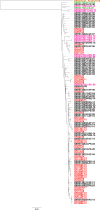Retrospective whole-genome comparison of Salmonella enterica serovar Enteritidis from foodborne outbreaks in Southern Brazil
- PMID: 33990934
- PMCID: PMC8324652
- DOI: 10.1007/s42770-021-00508-0
Retrospective whole-genome comparison of Salmonella enterica serovar Enteritidis from foodborne outbreaks in Southern Brazil
Abstract
Salmonella enterica serovar Enteritidis is frequently isolated from animal-source foods associated with human salmonellosis outbreaks. This serovar was spread to animal (mainly poultry) farms worldwide in the 1980s, and it is still detected in foods produced in many countries, including Brazil. The present study reports a retrospective genome-wide comparison of S. Enteritidis from foodborne outbreaks in Southern Brazil in the last two decades. Fifty-two S. Enteritidis isolates were obtained from foodborne outbreaks occurring in different cities of the Brazilian southernmost State, Rio Grande do Sul (RS), from 2003 to 2015. Whole-genome sequences (WGS) from these isolates were obtained and comparatively analyzed with 65 additional genomes from NCBI. Phylogenetic and Bayesian analyses were performed to study temporal evolution. Genes related to antibiotic resistance and virulence were also evaluated. The results demonstrated that all S. Enteritidis isolates from Southern Brazil clustered in the global epidemic clade disseminated worldwide originally in the 1980s. Temporal analysis demonstrated that all Brazilian isolates had a tMRCA (time to most recent common ancestor) in 1986 with an effective population size (Ne) increase soon after until 1992, then becoming constant up to now. In Southern Brazil, there was a significant decrease in the spreading of S. Enteritidis in the last decade. In addition, three antibiotic resistance genes were detected in all isolates: aac(6')-Iaa, mdfA, and tet(34). These results demonstrate the high frequency of one only specific S. Enteritidis lineage (global epidemic clade) in foodborne outbreaks from Southern Brazil in the last two decades.
Keywords: Brazil; Foodborne outbreaks; Salmonella enterica.
© 2021. Sociedade Brasileira de Microbiologia.
Conflict of interest statement
The authors declare no competing interests.
Figures






Similar articles
-
Recent Evolution and Genomic Profile of Salmonella enterica Serovar Heidelberg Isolates from Poultry Flocks in Brazil.Appl Environ Microbiol. 2021 Oct 14;87(21):e0103621. doi: 10.1128/AEM.01036-21. Epub 2021 Aug 18. Appl Environ Microbiol. 2021. PMID: 34406824 Free PMC article.
-
Genome analysis reveals insights into high-resistance and virulence of Salmonella Enteritidis involved in foodborne outbreaks.Int J Food Microbiol. 2019 Oct 2;306:108269. doi: 10.1016/j.ijfoodmicro.2019.108269. Epub 2019 Jul 17. Int J Food Microbiol. 2019. PMID: 31330452
-
Serological characterization and prevalence of spvR genes in Salmonella isolated from foods involved in outbreaks in Brazil.J Food Prot. 2004 Jun;67(6):1229-33. doi: 10.4315/0362-028x-67.6.1229. J Food Prot. 2004. PMID: 15222555
-
Antimicrobial Resistance in Nontyphoidal Salmonella Isolated from Human and Poultry-Related Samples in Brazil: 20-Year Meta-Analysis.Foodborne Pathog Dis. 2017 Feb;14(2):116-124. doi: 10.1089/fpd.2016.2228. Epub 2016 Dec 6. Foodborne Pathog Dis. 2017. PMID: 27922763
-
A Review on Microbiological Source Attribution Methods of Human Salmonellosis: From Subtyping to Whole-Genome Sequencing.Foodborne Pathog Dis. 2024 Mar;21(3):137-146. doi: 10.1089/fpd.2023.0075. Epub 2023 Nov 29. Foodborne Pathog Dis. 2024. PMID: 38032610 Free PMC article. Review.
Cited by
-
Recent Evolution and Genomic Profile of Salmonella enterica Serovar Heidelberg Isolates from Poultry Flocks in Brazil.Appl Environ Microbiol. 2021 Oct 14;87(21):e0103621. doi: 10.1128/AEM.01036-21. Epub 2021 Aug 18. Appl Environ Microbiol. 2021. PMID: 34406824 Free PMC article.
-
Emergence, Dissemination and Antimicrobial Resistance of the Main Poultry-Associated Salmonella Serovars in Brazil.Vet Sci. 2022 Aug 3;9(8):405. doi: 10.3390/vetsci9080405. Vet Sci. 2022. PMID: 36006320 Free PMC article. Review.
References
-
- World Organisation for Animal Health (2019) Prevention, detection and control of Salmonella in poultry. https://www.oie.int/index.php?id=169&L=0&htmfile=chapitre_prevent_salmon.... Accessed 07 Feb 2020
MeSH terms
Grants and funding
LinkOut - more resources
Full Text Sources
Other Literature Sources

